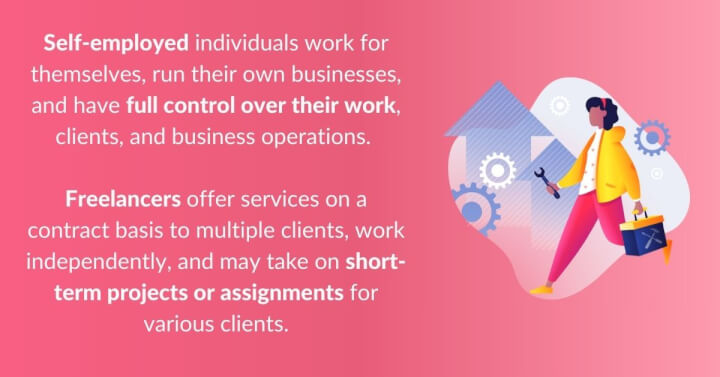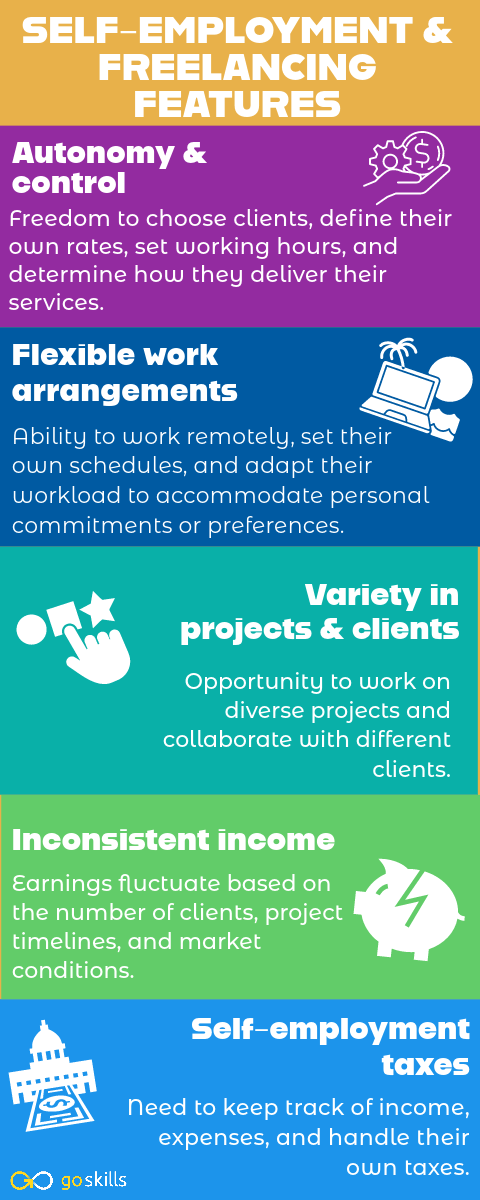As more and more people choose to work outside of traditional employment structures, it's important to understand the distinctions between self-employment and freelancing and how they apply to independent contractors.
Below, we’ll delve into their nuances, covering financial considerations, work-life balance, and more. Let's get started and equip you with the knowledge you need to supplement the tools you have available to thrive as a freelancer or self-employed individual. 
Defining self-employment and freelancing
Firstly, let’s define self-employment and freelancing, highlighting their core characteristics:
Self-employment
Self-employment refers to individuals who work for themselves and run their own businesses. Self-employed individuals have full control over their work, clients, and business operations. They manage day-to-day activities, find clients, deliver services, and handle administrative tasks. Common examples of self-employed individuals include entrepreneurs, business owners, and independent consultants.
Freelancing
On the other hand, freelancing involves offering services on a contract basis to multiple clients. Freelancers typically work independently and may take on short-term projects or assignments for various clients. As freelancers, they have the freedom to choose the projects and clients that align with their expertise and interests. Freelancers often have specialized skills in fields such as graphic design, writing, programming, or consulting.

The link between self-employment and freelancing
Both self-employed individuals and freelancers are considered independent contractors. Being an independent contractor means they are not considered employees but rather enter into contractual agreements to provide services to clients or businesses. As independent contractors, they have flexible work arrangements, but they are responsible for managing their own taxes, finances, and legal obligations.
Now that you understand these core concepts, we can now explore the similarities and differences between self-employment and freelancing, shedding light on their unique aspects.
Let's continue our journey through the world of independent contracting and uncover the intriguing facets of these career choices.
Independent contractors are not considered employees but rather, enter into contractual agreements to provide services to clients or businesses.
Similarities between self-employment and freelancing
Despite their distinct approaches to work, self-employment and freelancing both entail common challenges and rewards. In this section, we’ll explore the shared characteristics and experiences of self-employed individuals and freelancers:
1. Autonomy and control
Self-employed individuals and freelancers enjoy a high level of autonomy and control over their work. They have the freedom to choose their clients, define their own rates, set their working hours, and determine how they deliver their services. This independence allows them to shape their careers based on their preferences and priorities.
2. Flexible work arrangements
Both self-employed individuals and freelancers benefit from flexible work arrangements. They have the ability to work remotely, set their own schedules, and adapt their workload to accommodate personal commitments or preferences. This flexibility provides a higher degree of work-life balance and the opportunity to pursue other interests outside of work.
3. Variety in projects and clients
As independent contractors, self-employed individuals and freelancers have the chance to work on diverse projects and collaborate with different clients. This variety offers opportunities for professional growth, exposure to new industries, and the chance to build a diverse portfolio.
4. Inconsistent income
One challenge that both self-employed individuals and freelancers face is the inconsistency of income. Rather than receiving a steady paycheck, their earnings can fluctuate based on the number of clients, project timelines, and market conditions. Managing cash flow and budgeting become crucial skills to navigate the ups and downs of income variation.
5. Self-employment taxes
Self-employed individuals and freelancers are responsible for handling their own taxes. They need to keep track of income, expenses, and potential benefits and deductions, and may need to pay estimated taxes quarterly. Understanding the tax obligations and considering professional guidance can help alleviate the complexities associated with self-employment taxes.
Though self-employment and freelancing have their unique aspects, these similarities demonstrate the shared experiences and challenges faced by independent contractors.
In the next section, we will dive into the differences between self-employment and freelancing, highlighting how these paths diverge. Let’s uncover the nuances that set each apart and further guide you in your understanding of independent contracting.
Differences between self-employment and freelancing
Self-employment and freelancing have key differences that shape their nature, including:
1. Level of control over work
Self-employed individuals often have more control over their work compared to freelancers. As business owners, they have the ability to shape their services, set pricing structures, choose the projects they work on, and have a stronger influence on their business direction. Meanwhile, freelancers typically work on projects based on client needs and may have less control over the scope and nature of the work they undertake.
2. Client relationships
Self-employed individuals often develop ongoing relationships with clients, as they are responsible for finding and retaining clients for their business. These relationships can lead to repeat business, referrals, and long-term partnerships. On the other hand, freelancers may work with various clients on a project-to-project basis, which may offer more variety but could result in less continuity in client relationships.
3. Project selection
Self-employed individuals select the projects they work on based on their expertise, interests, and business goals. They can choose to focus on specific niches or industries, allowing them to develop specialized knowledge and become known experts in their field. Although freelancers may have some discretion in project selection, they often rely on client demand and may have less control over the types of projects they work on.
4. Business ownership and scale
Self-employed individuals typically have a higher level of business ownership, as they are responsible for managing all aspects of their business, including marketing, branding, and growth strategies. They have the potential to scale their business and expand with employees or team members. On the other hand, freelancers may operate as individuals or small teams, focusing on providing specialized services rather than growing a larger business entity.
6. Administrative and operational responsibilities
While both self-employed individuals and freelancers have administrative and operational responsibilities, the extent of these responsibilities may vary. Self-employed individuals have broader responsibilities, including bookkeeping, marketing, customer relationship management, and other business-related tasks. While they still have administrative duties, freelancers may focus more on project delivery and client communication.
Self-employment vs freelancing: Summary
| Self-Employment | Freelancing | |
|---|---|---|
| Level of control | Full freedom to shape their services, set pricing structures, choose projects, and are more actively involved in directing their business. | Less control over the scope and nature of the work they undertake. Projects tend to be based on client need. |
| Client relationships | Often develop ongoing relationships with clients, as they are responsible for finding and retaining clients for their business. | May work with various clients on a project-to-project basis, which may offer more variety but could result in less continuity in client relationships. |
| Project selection | Project selection based on expertise, interests, and business goals. | Often rely on client demand and may have less control over the types of projects they work on. |
| Business ownership & scale | Responsible for managing all aspects of their business, including marketing, branding, and growth strategies. | Operate as individuals or small teams, focusing on providing specialized services rather than growing a larger business entity. |
| Administrative and operational responsibilities | Have broader responsibilities, including bookkeeping, marketing, customer relationship management, and other business-related tasks. | Focus more on project delivery and client communication. |
Understanding these differences can help you assess which path aligns better with your goals and preferences as an independent contractor. In the next section, we will delve into the financial considerations specific to self-employment and freelancing, providing valuable insights to support your journey as an independent contractor.
Financial considerations for self-employed individuals and freelancers
Independent contracting provides flexibility and autonomy, but it also requires careful consideration and management of finances to ensure success. In this section, we’ll discuss the financial aspects of self-employment and freelancing.
Setting rates
One of the critical challenges for self-employed individuals and freelancers is determining the rates they will charge for their services. It’s essential to accurately price services to ensure profitability and remain competitive within the industry. Research is critical in determining competitive pricing structures, and this may evolve as you gain experience and become more specialized in your craft.
Securing payment
Payment collection is another vital aspect of financial management. Establishing clear payment terms upfront, issuing invoices promptly, and following up on overdue payments are essential tasks to maintain cash flow and profitability. It’s always wise to maintain a positive and professional relationship with clients while enforcing payment term policies.

Managing taxes
As we mentioned before, self-employed individuals and freelancers are responsible for managing their taxes. This responsibility means keeping detailed records to calculate any deductions appropriately. Consider consulting with a financial advisor or a tax specialist to ensure you’re aware of any potential tax considerations specific to your industry and earning potential.
Planning for retirement and insurance
As independent contractors, self-employed individuals and freelancers need to create retirement plans and insurance to protect them in case of unexpected circumstances. Setting up a retirement plan such as an IRA or 401(k) and purchasing a life and disability policy is wise to prepare for the future and protect against unexpected expenses related to life or work.
Work-life balance and flexibility
One of the primary advantages self-employment and freelancing offer is the option for work-life balance and flexibility. However, achieving this balance can also be challenging when managing client expectations, deadlines, and other demands. Here are some tips to promote work-life balance and flexibility.
1. Establish work hours and personal boundaries
Designated work hours help create a structure for your workday, helping increase productivity and efficiency. Clear boundaries between work and personal life can also decrease stress and allow individuals to switch off from work completely, promoting mental and physical rest.
2. Prioritize time management
Effective time management is critical to achieving a work-life balance. When working for yourself, it is essential to identify your most productive time and maximize that window. Effectively scheduling and prioritizing tasks will facilitate a more organized and effective workflow.
3. Collaborate internally and externally
Collaborating with other self-employed individuals and freelancers can help support your success and promote balance. Seeking internal support from colleagues or work-sharing spaces can be a way to share knowledge and insights and navigate similar challenges. Joining associations or networking groups within the industry promotes expanding your external support and helps you seek opportunities.
4. Rest and recharge
Lastly, make self-care a priority. Taking breaks, walking, or participating in leisure activities are proven ways to recharge and boost productivity. It is essential not to overlook prioritizing and taking care of yourself.
Balancing work deadlines and personal demands can be challenging, but by integrating these tips into your workday, work-life balance and flexibility can be achieved.
 |
Read our full list of 14 ways to improve work-life balance. |
Bottomline
Self-employment and freelancing offer unique opportunities for individuals seeking independence and career flexibility. Understanding the differences between self-employment and freelancing, as well as the financial considerations and benefits, is key to thriving in the world of independent contracting.
Whether you're considering becoming a freelancer or a self-employed individual, remember to assess your goals, skills, and preferences to determine your best path. Embrace the autonomy, creativity, and opportunity that come with independent contracting.
Ready to take charge of your career and embark on the path of self-employment or freelancing? To do this, you'll need more than just technical know-how in your main area of expertise. Consider your skill-readiness in areas like finance, project management, and, often-overlooked, soft skills. Check out hundreds of business resources, updated every week, right here.
Start your free trial
Get access to 110+ bite-sized courses, taught by award-winning instructors
Start free trial



